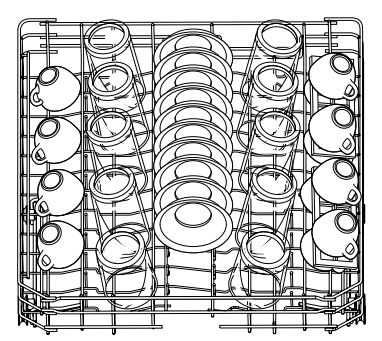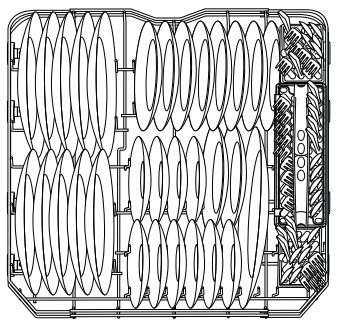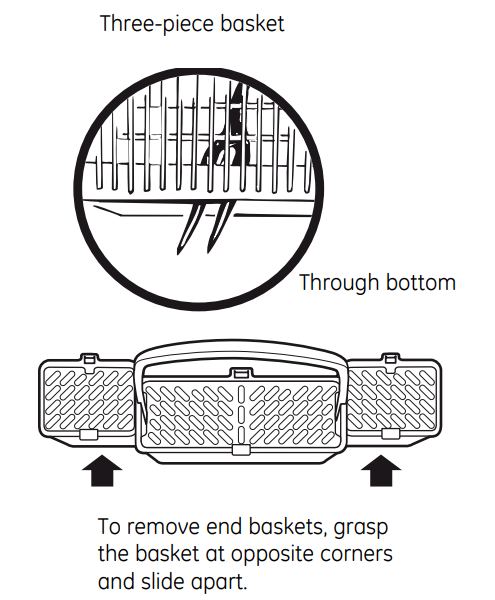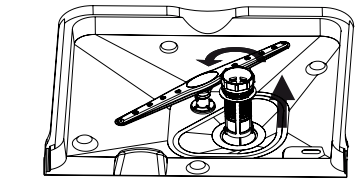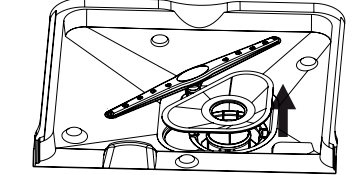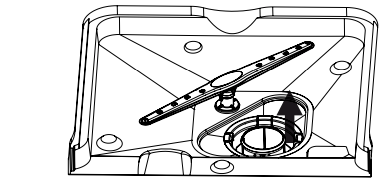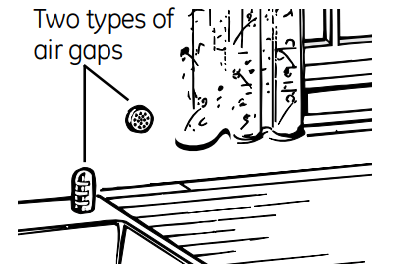Documents: Go to download!
- Owner's manual - (English)
- About the dishwasher control panel.
- Using the dishwasher.
- Caring for the dishwasher.
- Before you call for service…
Table of contents
Owner's manual Dishwashers
About the dishwasher control panel.

Control Settings
 ON/OFF
ON/OFF
With door open, press ON/OFF button to turn the unit ON to begin operation and OFF at the end of a wash cycle. The ON/OFF light is displayed when the dishwasher is ON.
 Wash Cycle Selections
Wash Cycle Selections
Press SELECT button to choose wash cycle. The light under the cycle name will display to indicate which cycle has been selected.
SANITIZE 4.8 gallons, 130 minutes
This cycle is meant to sanitize dishes and glasses with added heat. If you select sanitize cycle, at the end of this cycle, the sanitized indicator will turn on .
HEAVY 6.7 gallons, 125 minutes
This cycle is meant for heavily soiled dishes or cookware with dried-on or baked-on soils. This cycle may not remove burned-on foods. Everyday dishes are safe to be used in this cycle.
NORMAL 3.8 gallons, 140 minutes
This cycle is meant for loads of everyday dishes, glasses and cookware with medium soils that have not been pre-rinsed.
LIGHT 4.8 gallons, 78 minutes
This cycle is meant for loads of everyday dishes, glasses and cookware with light soils that have been pre-rinsed. GLASSES 3.9 gallons, 76 minutes
This cycle is meant for lightly soiled glassware. This cycle has less heating during the wash and rinse to protect your glassware. This cycle also has a lower temperature heated dry.
SPEED 5.8 gallons, 78 minutes
This cycle is meant for loads of everyday dishes, glasses and cookware with medium soils that have not been pre-rinsed. This cycle features reduced wash times to allow for faster cycle completion. This cycle also has a reduced time heated dry.
RINSE 1.9 gallons, 26 minutes
For rinsing partial loads that will be washed later. Do not use detergent with this cycle. This cycle does not include heated dry.
 Delay Start Option
Delay Start Option
This option allows you to delay the start of a wash cycle for up to 24 hours.
NOTE:To cancel the DELAY HOURS option before the start of the cycle, repeatedly press the DELAY HOURS button until the display is blank or reads "00.”
 2 Digit Display
2 Digit Display
This display is used for DELAY START and cycle time countdown.
When a cycle is selected, this display is populated with the total number of minutes in the cycle (up to 99 minutes). For cycle times above 99 minutes the display will read "99”.
 Starting a Cycle
Starting a Cycle
After selecting the wash cycle (Step 2) and DELAY START (Step 3), if desired, close the door of the dishwasher to start the cycle or begin the DELAY START countdown. When the door is closed, there will be a 5 second delay followed by a 60 second pump out before the water fill begins.
 Status Indicators
Status Indicators
SANITIZED If the SANITIZE cycle is selected, the sanitized indicator light will be turned on at the end of the cycle. If the NSF requirements for sanitization are not reached, the light will not turn on.
CLEAN The green light will display and a beep will sound to alert you that the wash cycle is complete. If the door is NOT opened, the beep will sound 4 times.
Using the dishwasher.
 Check the Water Temperature
Check the Water Temperature
The entering water should be at least 120°F and not more than 150°F for effective cleaning and to prevent dish damage. Check the water temperature with a candy or meat thermometer.
Turn on the hot water faucet nearest the dishwasher, place the thermometer in a glass and let the water run continuously into the glass until the temperature stops rising
 Use Cascade Crystal Clear® Rinse Agent
Use Cascade Crystal Clear® Rinse Agent
Cascade Crystal Clear® rinse agent removes spots and prevents new film buildup on your dishes, glasses, flatware, cookware and plastic.
Filling the Dispenser
The rinse agent dispenser holds 3.5 oz. of rinse agent. Under normal conditions, this will last approximately one month. Try to keep it full, but do not overfill.
- Make sure the dishwasher door is fully open.
- Turn the dispenser cap to the left and lift it out.
- Add rinse agent until the indicator window looks full.
- Clean up any spilled rinse agent with a damp cloth.
- Replace the dispenser cap.
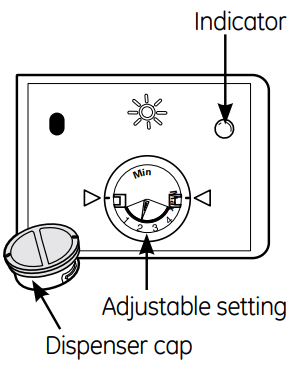
Rinse Aid Setting
The amount of rinse agent released into the final wash can be adjusted. The factory setting is at the midpoint. If there are rings of calcium (hard water) spots on dishes, try a higher setting. If you observe foam in the final rinse, try a lower setting.
To adjust the setting
Remove the dispenser cap; then turn the adjuster counterclockwise to increase the amount of rinse agent or clockwise to reduce the amount of rinse agent dispensed.
Dish Preparation Prior to Loading
- No prerinsing of normal food soil is required if using Heavy, Normal or Speed wash cycles.
- Scrape off hard soils, bones, toothpicks, skins and seeds.
- Remove large quantities of any remaining food.
- Remove leafy vegetables, meat, trimmings and excessive amounts of grease or oil.
- Remove acidic food soils that can discolor stainless steel.
 Proper Use of Detergent
Proper Use of Detergent
Use only detergent specifically made for use in dishwashers. Cascade® Automatic Dishwashing Detergent has been approved.
Keep your detergent fresh and dry. Don't put detergent into the dispenser until you're ready to wash dishes.
The amount of detergent to use depends on whether your water is hard or soft. With hard water, you need extra detergent. With soft water, you need less detergent.
Protect your dishes and dishwasher by contacting your water department and asking how hard your water is. Twelve or more grains is extremely hard water. A water softener is recommended. Without it, lime can build up in the water valve, which could stick while open and cause flooding. Too much detergent with soft water can cause a permanent cloudiness of glassware, called etching.
Use the information in the table below as a guideline to determine the amount of automatic dishwasher detergent to place in the dispenser.
When using automatic dishwasher detergent tablets, simply place one tablet in the dispenser and close the cover.
Number of Grains | 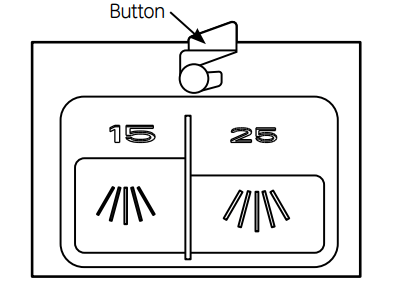 To open the wash cover, press the button and the cover will flip back. 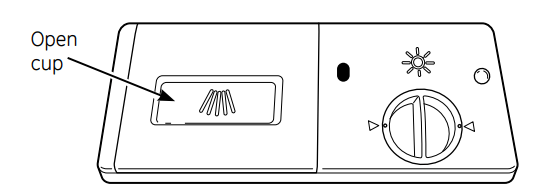 For heavily-soiled loads, use the HEAVY wash cycle and add a little extra detergent. DO NOT USE HAND DISH DETERGENT 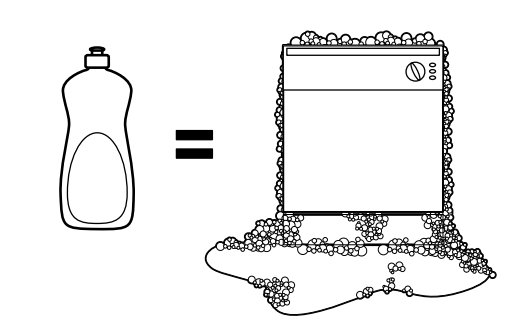 NOTE: Using a detergent that is not specifically designed for dishwashers will cause the dishwasher to fill with suds. During operation, these suds will spill out of the dishwasher vents, covering the kitchen floor and making the floor wet. Because so many detergent containers look alike, store the dishwasher detergent in a separate space from all other cleaners. Show anyone who may use the dishwasher the correct detergent and where it is stored. While there will be no lasting damage to the dishwasher, your dishes will not get clean using a dishwashing detergent that is not formulated to work with dishwashers.
|
Problem |
| |
| ||
| Rinse agent was spilled |
| |
Stained dishwasher parts
| Detergent with colorant was used |
|
| Some tomato-based foods can stain |
| |
| Dishwasher won't run | Fuse is blown, or the circuit breaker tripped |
|
| Power is turned off |
| |
| Reboot your control |
| |
| Steam | This is normal |
|
| Beeping at the end of the cycle | This is normal |
|
| Dishes and flatware not clean | Low inlet water temperature |
|
| Water pressure is temporarily low |
| |
| Air gap is clogged |
| |
| Improper rack loading |
| |
| No air gap or high drain loop |
| |
| Filter needs cleaning |
| |
| Spots and filming on glasses and flatware | Extremely hard water |
|
| Low inlet water temperature |
| |
| Overloading the dishwasher / Improper loading |
| |
| Old or damp powder detergent |
| |
| Rinse agent dispenser empty Too little detergent |
| |
| Cloudiness on glassware | Combination of soft water and too much detergent |
|
| Water temperature entering the dishwasher exceeds 150°F |
| |
| Black or gray marks on dishes | Aluminum utensils have rubbed against dishes |
|
| Yellow or brown film on inside surfaces | Tea or coffee stains |
WARNING Before cleaning interior wait at least 20 minutes after a cycle for the heating element to cool down. Failure to do so can result in burns. |
| An overall yellow or brown film can be caused by iron deposits in water |
| |
| White film on inside surfaces | Hard water minerals |
|
| Dishes don't dry | Low inlet water temperature |
|
| Rinse agent dispenser is empty |
| |
| Control panel responded to input but dishwasher never filled with water | Door latch may not be properly seated |
|
| Water vale may be turned off |
| |
| Dishwasher beeps once every 15 seconds | This is normal |
|
| This is a reminder that the door has been left open during operation |
|
See other models: JSP34WW4WW JB680SP2SS AZ25E12D2CM1 PSC23NHSABB PSD3230Z00WW
Download User Manual

GE - General Electric in United States
1-800-432-2737 Monday - Friday: 7 a.m. - 10 p.m. ET Saturday - Sunday: 8 a.m. - 6 p.m. E
GE - General Electric GLDT696D02SS Questions and Answers
GE - General
Owner manual PDF of GE - General Electric GE Built-In Dishwasher with Hidden Controls GLDT696D02SS.
Use manuals file type: PDF. GE - General Electric - Dishwashers
Related Products
- GE - General Electric GLDT696DSS
- GE - General Electric GLDT696D00SS
- GE - General Electric GLDT696JSS
- GE - General Electric GLDT696TSS
- GE - General Electric GLDT696J00SS
- GE - General Electric GLDA696P02SS
- GE - General Electric GLDT690D02WW
- GE - General Electric GLDT690D02BB
- GE - General Electric GLDA696F02SS
- GE - General Electric GLDT696T00SS
- GE - General Electric GLDT690DBB
- GE - General Electric GLDT690DWW
- GE - General Electric GLDT690JBB
- GE - General Electric GLDT690JWW
- GE - General Electric GLDT690TBB
 Forget to Add a Dish?
Forget to Add a Dish?